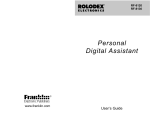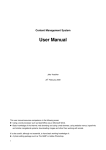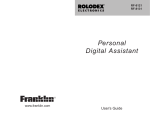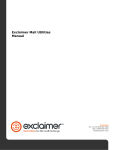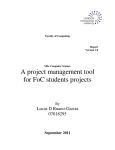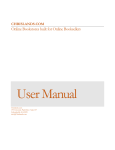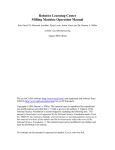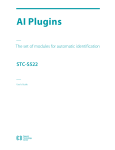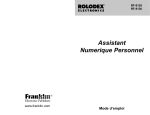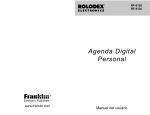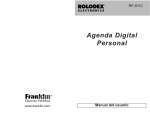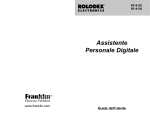Download CMS user manual 2.0.odt
Transcript
Syml 2.0 Website Management System User Manual Jake Voelcker 7th September 2007 tel: +44 (0)845 223 5328 e-mail: [email protected] www: http://webdesign.jake-v.co.uk 1 Table of Contents 1. General Introduction....................................................................................................................................3 2. License and Requirements..........................................................................................................................4 2.1 Licenses................................................................................................................................................4 2.2 System Requirements..........................................................................................................................4 2.3 User Requirements...............................................................................................................................4 3. Key Concepts..............................................................................................................................................5 4. Logging Into the Syml System.....................................................................................................................6 5. Navigation....................................................................................................................................................7 5.1 Viewing and Accessing Existing Items..................................................................................................7 5.2 Editing the website and viewing changes simultaneously.....................................................................7 5.3 Adding New Items.................................................................................................................................8 5.4 Moving Children to a Different Parent Item...........................................................................................8 5.5 Deleting Items.......................................................................................................................................8 5.6 Moving Items Up and Down..................................................................................................................9 5.7 Editing Existing Items...........................................................................................................................9 6. Adding and editing items............................................................................................................................10 6.1 Adding or editing a new Main Menu item, Directory or Page..............................................................10 6.2 Titles...................................................................................................................................................10 6.3 Appearance and Style........................................................................................................................11 6.4 Main Content......................................................................................................................................12 6.5 Menus, Links & Navigation.................................................................................................................18 6.6 Search Engines..................................................................................................................................20 6.7 Adding or editing images in an Image Gallery....................................................................................21 2 1. General Introduction Syml is a website Content Management System, a method of enabling website owners with little knowledge of web design to maintain, update and expand their own websites. At the heart of Syml is a small wordprocessor like application which facilitates the addition, modification and formatting of text as well as links, images, and downloadable documents. Syml also takes care of the structure of the website, automatically building menus and links from page to page, and organising pages into groups, images into galleries, and products into e-commerce shop displays. The word 'Syml' means 'simple' in Welsh, and was chosen as the name for this Website Management System because it reflects both its simplicity in use and its multilingual capability. Syml is released as open source software which means that you are free to modify, copy, and redistribute it without charge provided you also make your modifications available to others. 3 2. License and Requirements Please visit http://webdesign.jake-v.co.uk to download Syml or to obtain a PDF copy of this user manual and related documentation. 2.1 Licenses Syml is released and licensed under the GNU General Public License (GPL) version 2.0. This means that you are free to copy, modify and redistribute the software in whole or in part for payment or for free in any way you see fit, provided you credit its original authors and make available to the public copies of both the original software and any of your modifications, without charge. Please refer to http://www.gnu.org/licenses/gpl.html for further information. This user manual is released and licensed under the Creative Commons Attribution NonCommercial ShareAlike 2.5 licence, meaning you can use, copy or redistribute it for noncommercial purposes provided you credit the original author and make both the original content and your modifications available to others. Please refer to http://creativecommons.org/licenses/by-nc-sa/2.5/ for further information. 2.2 System Requirements Syml requires: A modern web browser with JavaScript enabled (e.g. Firefox 1.0+, Internet Explorer 6.0+, Opera 9.2+). An internet connection with the ability to browse the web. 2.3 User Requirements This user manual assumes competence in the following areas: Using a word processor such as OpenOffice.org Writer or Microsoft Word. Basic knowledge of web browsing including downloading images, PDFs and other files. It is also useful, although not essential, to have basic working knowledge of: A photo editing package such as The GIMP or Adobe Photoshop. 4 3. Key Concepts Web pages in the Syml Website Management System are arranged in hierarchical order, all stemming from a single 'root' and branching out into a family tree of separate items. There are five basic categories of items: Main Menu item – may contain directories and/or pages and/or may have embedded text and images. Directory item – may contain other directories and/or pages and/or may have embedded text and images. Page item – contain only embedded text and images. Images Galleries – which may have embedded text and images, as well as photos and images as children arranged in a gallery which is separate from the text content. FAQs Pages – 'frequently asked questions': lists of information presented in question-and-answer format. Systems which have E-commerce enabled also contain a fifth category of item: Product Galleries – may have embedded text and images, as well as products or services for sale which are arranged in a product gallery (see separate E-commerce Manual for more information). Each item has a parent (except for the main root item); and each item can contain children (except for page items). Some items have more than one parent because they appear on multiple menus or directories. Other than having parents and/or children, all other attributes are directly embedded into each item. These attributes define that item's title, subtitle and date as well as the main body of text and embedded images. All items have properties of this type. In bilingual systems, each item will have two titles, two subtitles etc. Each of these items can be loosely thought of to represent a single web page from the perspective of someone browsing the website. Menus and directories have the additional ability to list the child items they contain, as well as displaying embedded text and images of their own in the same way that pages can; pages simply display text and images and contain no child items. All changes made in the Website Management System appear immediately on the website with no delay. 5 tabs browser such as Internet Explorer, choose the 'New window' option from the 'File' menu. Then, in your browser's new tab or new window, type the website address. This will display the website complete with any recent changes. You can now switch back and forth between the two tabs or the two windows, editing and then viewing the results. But whenever you switch from the Management System to the website, remember to press your browser's 'Reload' or 'Refresh' button to view the most recent changes. 5.3 Adding New Items The basic procedure for adding most types of new items is to click the “Add Main Menu Item”, “Add Directory”, “Add Page”, “Add Image Gallery” or “Add FAQs Page” link above the main table. The precise procedure for adding the various types of items is slightly different – see page 10 for adding pages, menus and directories; see page 21 for adding image galleries and FAQs pages. See the separate E-commerce Manual for adding products. Note that all new items appear immediately on the website as soon as the 'submit' button is clicked. 5.4 Moving All Children to a Different Parent Item It is possible to move all the child items within a menu item or directory to a different parent at once. If the new parent which will host the child items does not yet exist, it must be created first – see page 10 for details of how to create a new menu item or directory. Once the new parent item exists, click the “Move to” link associated with the old parent item which currently contains the children. A drop-down menu will appear containing a list of all other existing parent items on the website. Select the new parent item to which you wish to move the children, and then click the “Submit” button at the bottom of the page. Notes: 1. To move a single item from one parent to another see the “Move this item to” option on page 19. 2. Although image galleries, product galleries and FAQs pages (including the items they contain) can be moved in this way, individual images, products and FAQs cannot. For example, an entire image gallery called “2006 photos” within a parent called “Current photos” could be moved to a new parent called “Archived photos”, but individual images called “photo 1”, “photo 2”, and “photo 3” could not be moved to a new gallery using this method. See page 16 for details about how to move images and FAQs from one parent to another. See the separate e-commerce manual for details about adding and moving products. 3. As well as moving a child from one parent to another, it is also possible to list children in more than one parent at a time. See page 18 for more details. 5.5 Deleting Items To delete an item, click the “Delete” link associated with that menu item. A confirmation box will appear. If you choose “Yes” or “OK”, that item will be deleted. If you choose “No” or “Cancel”, the confirmation box will disappear and the item will remain intact. Note that deleted items disappear from the website immediately and permanently. Note: deleting a menu item or directory causes its children to become orphaned, but creating a new parent with the same filename as the old one (see page 18) will re-enable the child items. Alternatively, orphaned children can be accessed from the “list all content” link on the Syml admin menu. 8 5.6 Moving Items Up and Down The order in which items are displayed depends on the settings defined in the parent item which contains them. For example, if a parent item called “events” is set to display its children in descending “start date” order, then items in the events calender will be displayed in reverse date order (see page 19 for more details). By default, each parent item is set to order its children by “position”. When children are ordered by “position”, you can manually change the order of the child items by taking the following actions. Note: any changes you make to the list order will appear immediately on the website. To change the position of an item so that it appears earlier or later in the list, click the “<” or “>” buttons associated with that item. Click these links multiple times to move an item several positions. To move an item to the start or end of the list or menu, click the “|<” or “>|” link. For items which appear in multiple menus or directories, changing its position in one list may change its position in all others as well. Please ensure you visit these lists and re-order as necessary. Note: the page will automatically reload after each click to reflect the changes made. This may take several seconds on a slow internet connection; do not click any buttons or links until the page has reloaded from the previous action. 5.7 Editing Existing Items To edit attributes such as text, colours and images of an existing item, click the “Edit” link associated with that item. See page 10 for editing pages, menus and directories; see page 21 for editing image galleries and FAQs pages. See the separate E-commerce Manual for editing product items. To edit the separate child items contained within a parent item, first click the “Browse” link associated with that parent item to access a new table of all the children; then click one of the “Edit” link of the relevant child item. 9 6. Adding and editing items 6.1 Adding or editing a new Main Menu item, Directory or Page To add a new main menu item, make sure you are in the main menu section by clicking “Pages and Menus” link at the very top of the page. Once this page has loaded, click the “Add Main Menu Item” link above the table of existing items to see a page containing the following options. To edit an existing main menu item, click the “Edit” link associated with that item to see a page containing the following options. To add a new directory or page, make sure you have first navigated to the menu item or directory which will contain the new item by clicking on the relevant “Browse” link(s). Once this page has loaded, click the “Add Directory” or “Add Page” link above the table of existing items to see a page containing the following options. To edit an existing directory or page, click the “Edit” link associated with that item. The “add” or “edit” page which is displayed after taking the above steps contains a number of grey boxes. Each grey box has a section title such as “Basic Details”, “Optional Details” or “Main Description”. Some of these sections are visible by default and some are hidden. Click the title of a hidden section to expand its box and view the contents, and vice-versa to hide the contents of a box which are currently visible. 6.2 Titles Title: This is the title which will appear at the top of the web page, so choose something short and descriptive – use 3 to 8 words as a guideline. This also the title which will appear in the title bar of the web browser used by visitors to view the website, further emphasising the importance of both descriptiveness and brevity. This title is also crucial to the listing and positioning of the page in search engines. It is therefore very important that the title contains at least one of the main keywords from the “Keywords” box (see below), and some of the most frequently occurring words from the “Main Description” box (see below). In bilingual systems, if the Welsh field is left blank the value from the English field will be automatically copied there. Subtitle: This is the opportunity for a slightly longer description. The subtitle often appears as a summary of the page's contents in directory listings, so it should describe in one sentence the contents of the page. The subtitle is also indexed by search engines so try to include two or three of the page's keywords. In bilingual systems, if the Welsh field is left blank the value from the English field will be automatically copied there. Title for menu link (mandatory for items which appear on menus): This is the abbreviated form of the title which will appear in the main menu and in other lists and directories. There is a character limit on this field to prevent the use of more than the allowed number of letters because it is absolutely crucial that menus are kept brief and do not exceed their size limit. Keep this title as short and snappy as possible – e.g. if the full title for this page is “Newsletters & Archived News”, the menu link could be “past news” or simply “news”. In bilingual systems, if the Welsh field is left blank the value from the English field will be copied there. Note: The “title” and “menu title” fields are also used for the HTML image 'alt' and 'title' tags, and the link 'title' tag: once again, it is of the utmost importance to choose something short, descriptive and keyword-rich. 10 6.3 Appearance and Style Start Date: This is the primary date field for this item. If an end date is also specified (see below), this field becomes the start date; if no end date is specified, this field is simply the main date for this page. End Date: This is the secondary date field for this item. This can be useful for conferences, projects of a specific duration or other events whose end date is different to their start date. If the end date is the same as the start date of if no end date is required, leave this field blank. Menu Colour: If implemented in your system, this defines the background colour of the menu button associated with this menu item. This also defines the menu colour for all its child items. Click the box with the black border, and then choose a colour from the palette which appears. If you decide to leave the existing colour intact and wish to hide the palette, click the 'Cancel' link at the bottom-right. Background colour: If implemented in your system, this defines the colour of this page's main background. This also defines the background colour for all its child items. See “Menu Colour” above for instructions on choosing a colour. Main Image: Although additional images can be uploaded as part of the “Main Description” box below, this is the main image used for this web page. Not only does a full-size version of this image appear on the page, but also a small thumbnail version appears in directory listings and other such parents of this page. Click the “Browse...” button to open a dialogue box which will allow you to choose an image from your computer to be uploaded to the Website Management System. It is recommended that JPG (Jpeg) or PNG images be used – do not attempt to upload uncompressed formats such as BMP (Bitmap) files. Even compressed images larger than 1024x768 pixels (i.e. the typical resolution of a 15” monitor or a 1 Megapixel digital camera) should not be uploaded. Large images must resized and compressed first using a suitable photo editing package such as Adobe Photoshop or The GIMP. Similarly, it is recommended that low-colour images such as limited-palette GIF files, or very low resolution files (smaller than approximately 100x100 pixels) should not be used because image quality will be poor. Uploading a new image will replace the existing one; placing a tick in the “delete image” box will remove the image when the submit button is clicked. If an image already exists for this page a small version (or thumbnail) will be displayed here. Note: the “Main Image” box is not used for image galleries. To choose a main image for an image gallery, browse the images it contains and select one of those instead. See page 21 for more details. Use the image from this item's first child as this item's thumbnail instead of its own main image: if the main image for this item is identical to the main image of one of its children, you may tick this box to use the child's main image instead of having to upload it again. This can also be done hierarchically, so that a if a grandparent and parent both have this option selected, the grandchild's cover image will be displayed in both cases. Mini gallery of Images: If enabled on your system, this allows you to specify which of the existing image galleries will be displayed as a Mini Gallery on this page. To view the images in each of the available galleries, click the “view” link next to its title – but remember to return to the Website Management System by using your browser's “back” button once you have finished viewing. See page 21 to learn about creating image galleries and uploading images. 11 6.4 Main Content Email address: use this box to specify an email address if this page requires one. This is useful for pages such as staff profiles or a website's 'Contact Us' page. The email address will appear at the bottom of the web page, below the main body of text defined in the “Main Description” box, below. Note: do not write email addresses in any other fields. This “Email address” field encodes the address, but addresses contained in any other fields such as the “Main Description” box will be published as plain text on the website, and as such may be subject to spamming, phishing, viruses and other nuisances or attacks. Content: this is the main text which will be displayed on this web page. Below are the various options contained in the word processor-style interface. [--Format--] drop-down box: should be used for the formatting of all normal text in line with your website's existing font face and colour scheme: Paragraph - use for all normal paragraphs. Heading 1 - use for large headings such as main page titles. Heading 2 - use for smaller headings such as subtitles. Heading 3 - white heading for use against dark backgrounds. Heading 4 to Heading 6 - various other smaller headings for use in photo captions, bulleted lists, column and row titles in a tables etc. [--Font family--] and [--Font size--] drop-down boxes: should only be used for creating special font effects where standard paragraph and header styles are not sufficient. Notes: 1. The '[Format]' function should normally be used for formatting text because this will keep all text consistent with the existing style of the website, and will mean that your text in the Main Description box is automatically updated and reformatted if the master font style of the website is changed. Only use the '[Font family]' and '[Font size]' controls for special font effects and bear in mind that these will remain unaltered even if the website's colour scheme or font style changes in the future. 2. You are advised not to paste pre-formatted text from a word processor, PDF, web page or similar source directly into the “Main Description” box. Such text is likely to contain formatting which is incompatible with this Website Management System. If you need to copy such text from an existing document, it is best to use the “Paste text only” button (see above) to remove all formatting. 3. Images and other such embedded files which are simply copied from a file saved on your computer and pasted into the “Main Description” box will not be uploaded to the website. Although such images may appear to be displayed normally on the local machine when editing and viewing the website, they will not be available on the internet and will be invisible to all external users. To avoid this, ensure you insert all images using the Image Manager. However, images which already exist on the website may be copied and pasted directly in to the “Main Description” box – for example, copying the contents of an existing web page on your website into a new one, or copying the contents of the English “Main Description” box into the “Welsh Description” box should not present any problems. 12 Standard Buttons: New document (discard all current content of the “Main Description” box) Bold text Italic Text Underlined text Strikethrough text Left-aligned paragraph Centred paragraph Right-aligned paragraph Justified paragraph Cut (only available in Microsoft Internet Explorer – in other browsers please use the Cut option on the browser's own Edit menu, or use the keyboard shortcut such as Ctrl X) Copy (only available in Microsoft Internet Explorer – in other browsers please use the Copy option on the browser's own Edit menu, or use the keyboard shortcut such as Ctrl C) Paste (only available in Microsoft Internet Explorer – in other browsers please use the Paste option on the browser's own Edit menu, or use the keyboard shortcut such as Ctrl V) Paste Text Only. Use this option to paste text from formatted sources such as web pages, word processor documents and PDFs. Paste from Word. Use this option to paste content from word processor documents if you want to preserve their existing formatting. Note: use with care and be aware that because of the noncompliance of Word with open source standards, some formatting may conflict with existing website styles, may be incompatible with some web browser and cause database problems. Find Find and replace Bulleted list Numbered list Decrease indent Increase indent Spellcheck (only available in Microsoft Internet Explorer) Undo Redo Insert link or edit file link (see page 15) Remove existing link Edit existing image (see page 17) Clean up HTML Display information about the text editor 13 View HTML code source Insert Current Date Insert Current Time Preview the contents of the “Main Description” box as it will appear on the website Display the total number of characters and words in the “Main Description” box Select text colour Select background colour Insert a new Table (see page 14) Insert a horizontal rule Remove all formatting from selected text Display or hide dotted lines for invisible elements (such as tables without borders) Superscript Subscript Insert accented or special character Insert new file link (see page 15) Insert new image (see page 16) Print the contents of the “Main Description” box Dialogue boxes: Insert table: Use this function to insert a table into the document. In the context of a website, tables can be useful not only for displaying facts and figures in columns and rows, but also when used 'invisibly' for page layout and formatting. First place your cursor at the position in the “Main Description” box where you would like the new table to appear. Then click the table button: Rows and columns: the total number of rows and columns the table will contains. Choose carefully, because there is no easy way of changing these numbers afterwards. Width: the overall width of the table in pixels. You may optionally specify the width of the table as a percentage of the overall page width instead by typing the % symbol after entering the desired number, e.g. 75%. Height: the overall height of the table in pixels. Border: the thickness of the border shown between cells in the table and around the perimeter of the table. Measured in pixels. Use a border thickness of 0 for an invisible table. Cellpadding: cells' internal margins, i.e. distance between the cell's border and its contents. Cellspacing: cells' external margins, i.e. distance between one cell and another. Alignment: the horizontal positioning of the table within the page. Once a table has been inserted, the array of buttons which may be used for table modification become active on the main toolbar. Please click the Help icon about using these table modification buttons. 14 on the toolbar for further details Insert link/edit file link: This function inserts a hyperlink to an existing web page. It can also be used to modify an existing file link (see below). First highlight the text in the “Main Description” box which you use to use as the hyperlink. Then click the hyperlink button to display a new window with the following options: Link URL: Insert the internet address of the link page (i.e. the page you are linking to). 1. For local pages simply insert the filename of the page, e.g. contact.php. To discover the address of a local page, view it in a your browser and copy its link from the address (location) bar. Local Welsh pages must be prefixed with 'welsh', e.g. 'welshcontact.php' 2. For remote pages, i.e. pages on other websites remember to add the http:// prefix, e.g. http://www.anotherdomain.com. Title: You may enter a descriptive link title here if you wish. Link titles help some partially sighted website users and may improve your page's performance in search engine rankings. Target: Select “same window” to open the link in the conventional manner in the current window, or select “new window” to ensure that when a user clicks on the link, the current page remains intact and the new page opens on top in a separate window. Normally “same window” is the best option. Insert new file link: Use this function to insert a file such as a PDF or word processor document, much in the same way that you would add an attachment to an email. This file will not be directly displayed in the web browser, but will be accompanied by a hyperlink which users can click to view and/or download the file. First highlight the text in the Main Description box which you wish to use as the hyperlink. Then click the Insert File Link button to display a new window with the following options: Existing file already on the website: The names of any files already on the website are displayed in a file browser. Single click any of the filenames to select a file. You can preview the selected file by clicking the Preview button at the top right of the window. URL: Clicking on any of the files will cause its location to also appear in the URL textbox. Upload: Click the 'Browse...' button to find a file on your computer and upload it to the website. Once the file has uploaded, click its filename in the file browser and follow the above instructions. Note: files to upload must not be larger than 2MB (2,000kb) in size. Caption: Clicking on any of the files will cause its filename to also appear in the Caption textbox. You may optionally change this to make is more descriptive if you so choose. Insert filetype icon: Ticking this box will cause a small icon representing the attached file to be inserted alongside the link to the new file in the “Main Description” box. Insert file size: Ticking this box will cause the file size to be displayed numerically alongside the link to the new file in the “Main Description” box. This information can be useful for larger files and for users on slow internet connections. Insert file modification date: Ticking this box will cause the file's datestamp (i.e. the date this file was last modified) to be displayed alongside the link to the new file in the “Main Description” box. 15 Insert new image: This function can be used for inserting images alongside the text. These are different to the page's main image (see “Main Image” above). For correct image placement it may also be necessary to use tables (see below). First place your cursor at the position in the “Main Description” box where you would like the new image to appear. Then click the Insert new image button to display a new window with the following options: Existing image already on the website: The names of any images already on the website are displayed in a file browser. Single click any of these files to select an image. You can preview the selected image by clicking the Preview button 16 at the top right of the window. URL: Clicking on any of the filenames will cause its location to also appear in the URL textbox. Border Width: This defines the thickness in pixels of the border which appears around the image. Specify a border width of 0 to remove the picture border. Alternative Text: This is the label which appears in the image placeholder whilst users on slow internet connections are waiting for the image to finish downloading, and is the image description for partially sighted users and others who do not use images. You should enter a descriptive caption for the image which will fully explain its content or meaning for those who do not see it. Including words in the image caption which also appear in the “Main Description” and “keywords” boxes may help boost your page's ranking in the search engines. Upload: Click the 'Browse...' button to find an image file on your computer and upload it to the website as a new image. Enter the width or height you wish to resize it to in the 'width' or 'height' box. Only one of these options need be specified: whichever would result in a smaller image will be used. Although images can be resized after insertion into the “Main Description” box, it is best to specify the desired image size now. Once the image has uploaded, click its filename in the file browser and follow the above instructions. Note: image files to upload must be 1024x768 pixel resolution or smaller, or approximately 300k file size or smaller. Edit existing image: Use this function to edit images which have already been inserted into the “Main Description” box using the Image Manager (see page 16). First single click the image you wish to edit, then click the edit image button to display a new window with the following options: Image URL: The location of the existing image file will appear in this textbox. Normally this field will not require modification. Image description: This is the label which appears in the image placeholder whilst users on slow internet connections are waiting for the image to finish downloading, and is the image description for partially sighted users and others who do not use images. You should enter a descriptive caption for the image which will fully explain its content or meaning for those who do not see it. Including words in the image caption which also appear in the “Main Description” and “keywords” boxes may help boost your page's ranking in the search engines. Alignment: This modifies the positioning of the image in relation to the surrounding text: • Baseline and Bottom: The first line of text is at the same height as the bottom edge of the image. All subsequent lines of text appear below the image. • Top and TextTop: The first line of text is at the same height as the top edge of the image. All subsequent lines of text appear below the image. • Middle: The first line of text appears halfway down the side of the image. All subsequent lines of text appear below the image. • Left: The image appears to the left of the paragraph, and all lines of text in that paragraph are displayed to the right of the image. • Right: The image appears to the right of the paragraph, and all lines of text in the paragraph are displayed to the left of the image. Dimensions: These textboxes allow you to modify the width and height of the image respectively. Typing a value in only one of these textboxes will cause the image to scale proportionally; typing a value in both textboxes may cause the image to distort. Note: although it is possible to modify the size at which the image is displayed by using these options, it is better to use an image of the correct size by specifying the desired dimensions when initially uploading the image in the Image Manager (see page 16). Border: Defines the thickness in pixels of the border which appears around the image. Specify 17 a border width of 0 to remove the picture border. Vertical Space/Horizontal Space: Defines the size in pixels of the margins at the top and bottom or left and right of the image which will be kept clear of text. 6.5 Menus, Links & Navigation Unique title for filename: This parameter defines the filename ascribed to this web page. For example, a value of “news” would result in a web page called “news.php”. If left blank, an automatic filename such as “73.php” will be generated; choose an alternative title if you would like your page to have a more recognisable or memorable filename. Welsh filenames are always a clone of the English with a “welsh” prefix, e.g. “welshnews.php” or “welsh73.php”. Note: do not use file extensions for this field. Any extensions will simply become part of the filename – e.g. “news.html” would become “news.html.php”. Link to external page: Use this parameter to define an external link to another web page or website as part of this page. For example, a value of “www.bbc.co.uk” would link to the main BBC website. The http:// prefix is added automatically. A different Welsh link can be defined if Welsh users are to be directed to a different web page or website, but if left blank the English link will automatically be used. • “Link directly to external website - open in the same window”: specifies that the link leads straight to the external website and open in the same window. Recommended for most links. • “Link directly to external website - open in a new window”: specifies that the link leads straight to the external website and open in a new window. • “Embed external page in this menu and display normal page content, navigation, header and footer”: specifies that the link leads to a normal page on your website but with the contents of the external website embedded within that page. Recommended only for simple external web pages whose formatting will not interfere with your website, and which can be displayed in a small area narrower than the full screen width. • “Embed external page as a scrolling frame in this menu and display normal page content, navigation, header and footer”: as above, but the external page is a fixed height with a scrollbar embedded in the page. • “Embed the external page at full width and display only a minimal title and header”: the external website will be displayed in full but with your own title and page header. Recommended in situations where you would like users to be able to easily return your website and homepage, but where the external website requires the full screen width. Custom page template: • By default the “standard.php” page template will be used. If in doubt, leave this field unchanged. • If a specific page template is required, the standard page template can be overridden by choosing the desired page template from the drop-down list of existing custom templates. For example, the form on the “Contact Us” page requires the “contact.php” template to be selected, and the sitemap page requires the “sitemap.php” template to be selected. 18 Category type: • If left blank, this field automatically selects the correct option as defined by the type of page you chose to add. For example, if you clicked on the “Add Main Menu Item” link, then the “Main Menu Item” option will now be selected in this field. If in doubt, leave this field alone. • If you wish to add a hidden page or new homepage, select the relevant option for this parameter. • If you wish to promote or demote a page to a new category – for example, converting a directory to a page – you can do so by selecting a new category here. Notes: 1. Demoting items which contain children (e.g. converting a directory to a page) will create orphan child items which are no longer accessible unless the parent is converted back into a directory or menu. 2. Hidden items are in no way locked or deleted, they are simply not listed in menus and directories. However, users who know the address of a hidden page will still be able to access and view it, and search engines such as Google which have already indexed hidden pages will continue to list. 3. When defined as being hidden, items such as menus or directories which previously contain child items lose the ability to be browsed: effectively their child items also become hidden. However, the child items are not deleted and upon restoration to directory or menu status, an item's child items will become visible again. Number of words to display from each child's Main Content: allows a snippet of text from the main content of each child to be displayed along with its title and subtitle when listed in this directory. Use this option to specify the length (in individual words) of the snippet. Leave blank or set to 0 to disable this feature. Also add to the following menus or directories: this allows the same page to appear in multiple menus or directories. A page always appears in its parent menu or directory, but you can cause it to also appear in other parents by ticking the corresponding box(es) here. Order this item's children by: This is the parameter which defines the order in which this item's children are displayed. There are essentially two separate variables: the criteria by which the children are sorted (e.g. start_date or title); and the order in which they are sorted according to this criteria (i.e. either ascending or descending). • If left blank, this field selects “position” and “descending”. If in doubt, leave this field blank. • Select the field by which child items are to be ordered in the drop-down box. Common options are “start_date”, “end_date”, “position” and “title”. To select the order in which child items are ordered, select either “Ascending” or “Descending”. “Ascending” orders lists with the the smallest or lowest values first and the largest or highest last; “Descending” orders lists with the largest or highest values first and the smallest or lowest last. Display this item's children in a: “Summary page”: display this item's children as a list directly in the page along with the other page content. “Submenu”: display this item's children as a submenu, separate from the other page contents. “Both”: do both of the above. Move this item to: This option allows you to move the page from its current location into a new menu or directory. The page will cease to be a child of its current parent, and will instead become the child of whichever menu or directory you select in the “move to” drop-down list. Any child items the current page may contain will in turn be transferred and thus will remain intact as children of this page in its new location. 19 6.6 Search Engines Approx. 10 keywords: these are the keywords used by search engines to index this page. In this box you should type between 8 and 12 keywords, all of which must appear at least once in the “Main Description” box below. Use only normal spaces to separate these keywords – do not use commas, full stops, semi colons or any other punctuation in this field, and do not repeat words unless they unavoidably form part of another word. The “Main Description” box below should contain a 7% keyword density for your most important keywords. Exclude from search engines indexing: Tick this box to request that search engines such as Google do not index this page. This can be useful for pages which change very frequently or which are not online for very long, but if in doubt leave this box blank. Notes: 1. This feature does not lock or hide this page in any way – internet users will still be able to access this page if they know its address. 2. This feature does not work instantly: pages already indexed by search engines will remain indexed until the search engine crawls the page again, a process which can take some days or weeks. 3. Not all search engines respect excluded pages: in some cases certain search engines will still index pages even if requested not to do so. Prevent from being cached: Tick this box to request that this page is not cached by web browsers. This can be useful for pages which contain sensitive information because it should prevent offline copies from being made. It can also be useful for ensuring that dynamic pages which change frequently such as search results or stock lists are not cached because this might result in some users viewing outdated search results or products which have sold out. If in doubt, leave this box blank. Note: this feature does not guarantee that copies of this page are not made. Not all browsers or web caches honour nocache requests, and this feature does not prevent users from manually saving a copy of the page. Add this item to the translation queue/Remove this item from translation queue: on systems which have automatic translation enabled, by default new pages are queued for translation but existing pages which have been modified are not. Use these options to override the default translation settings. Remember to visit the 'Translation' section of the Website Management System to send an automated email to the translator when you are done (translators: please see the separate Translation Manual for more information). Upload to Website: click the 'Submit' button when you are sure you have filled in all required fields correctly and you are ready to publish this page on the website. Note that as soon as the 'Submit' button is clicked, your changes will appear immediately on the website. Note: you are advised to copy and paste your 'Main Description' text into a word processor and save a copy to your computer before clicking the 'Submit' button in case of a connection failure. 20 6.7 Adding or editing images in an Image Gallery To add a new image gallery, make sure you have first navigated to the menu item or directory which will contain the new gallery by clicking on the relevant “Browse” link(s). Once the page has loaded, click the “Add Image Gallery” link above the table of existing items. A new page will appear, whose contents are identical to those described in the “Adding menu items, directories and pages” section above. Please see page 10 for details. Fill in the desired level of detail on this page and submit it. Once this new empty image gallery has been created in this manner, click its “Browse” link (see page 7 for details) to see a page with the following options. Add another [?] item(s): use this option to add new images to this gallery. This will add an empty record to the page which you can fill by entering the following values. Enter the desired number of new images in the box and then click the 'Go' button to use this facility. Note: If you have made changes to the contents of any of the existing records, make sure you click the “Submit” button at the bottom of the page before clicking the “Go” button to add more images. Clicking on the “Go” button without clicking “Submit” first will cause any unsubmitted changes to be lost. Image File: select the image you would like to upload to the gallery. Click the “Browse...” button to open a dialogue box which will allow you to choose an image from your computer. It is recommended that JPG (Jpeg) or PNG images be used – do not attempt to upload uncompressed formats such as BMP (Bitmap) files, or other non-image formats such as PDF files or word processor documents. Images larger than 1024x768 pixels (the typical resolution of a 15” monitor ar a 1 Megapixel digital camera) should not be uploaded without being resized and recompressed using a photo editor such as Photoshop or The GIMP. Similarly, it is recommended that low-colour images such as limited-palette GIF files, or very low resolution files (smaller than approximately 100x100 pixels) should not be used because image quality will be poor. Existing images may be replaced simply by clicking on “Browse...” and selecting a new image file to upload. Remove from this gallery: To remove an image from the current gallery, tick the “remove from this gallery” box associated with that image and then click the “Submit” button at the bottom of the page. The image will then no longer appear on this gallery, but will remain available on the list of all images. To view an image once it is no longer displayed in any galleries, click the “image library” link on the admin menu. Note: to retain an image's details such as title, caption etc. but replace the image itself, simply click the “Browse...” button and choose a new image from your computer. The new image will be uploaded to the website and will replace the existing one. Image Title: this is the title which will appear alongside the image when it is viewed as a thumbnail, and is the title which will appear above the image when the full-size version is viewed on a page of its own. Image Caption: optionally enter two or three sentences to describe or explain the image. All formatting from text in this box is removed, including line breaks, tabs etc. so that the entire description automatically appears as a single paragraph in the normal font face. |< , < , > , >| buttons: this is the position of the photograph in the gallery, i.e. the order in which images are displayed. To change the position of an item so that it appears earlier or later in the list, click the “<” or “>” buttons associated with that item. Click these links multiple times to move an item several positions. To move an item to the start or end of the list or menu, click the “|<” or “>|” link. For items which appear in multiple menus or directories, changing its position in one list may change its position in all others as well. Please ensure you visit these lists and re-order as necessary. 21 Use as gallery cover image: Select this option to select which image should be used as the cover image for this gallery. The cover image appears as a thumbnail alongside the gallery's title and subtitle wherever it is listed in directories or menus on the website. To use a different cover image for this gallery, simply select the “Use as gallery cover image” option next to that image instead. To use no cover image for this gallery, select the “No gallery cover” option at the top of the list. Also appears in: This option allows the same image to be displayed in multiple galleries on the website. Select which other galleries you would like each image to be displayed in by ticking the relevant box(es) on the list of all galleries. Note: To move an image from one gallery to another, first use this option to display it in both galleries. Then you may visit the second gallery an untick the relevant box to remove the image from the original gallery. Add this item to the translation queue/Remove this item from translation queue: On systems which have automatic translation enabled, by default image galleries are not translated. Use these options to add an image gallery to the queue for translation, or to remove an image gallery from the queue if it no longer requires translation. Remember to visit the 'Translation' section of the Website Management System to send an automated email to the translator when you are done (see the separate Translation Manual for more information). Upload to Website: click the 'Submit' button when you are sure you have filled in all required fields correctly and you are ready to publish this gallery on the website. Note that as soon as the 'Submit' button is clicked, your changes will appear immediately on the website. 22






















